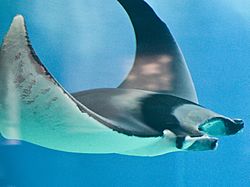Ray facts for kids
Rays are a fascinating group of fish. They are part of a larger group called Batoids. There are over 500 different kinds, or species, of rays. They belong to thirteen families and four main groups called orders. Unlike most fish, rays don't have bones. Their skeletons are made of cartilage, which is a flexible material like the tip of your nose or ear.
Quick facts for kids Batoidea |
|
|---|---|
 |
|
| Devil fish, Mobula mobular | |
| Scientific classification |
|
| Kingdom: | Animalia |
| Phylum: | Chordata |
| Class: | Chondrichthyes |
| Subclass: | Elasmobranchii |
| Superorder: | Batoidea |
| Orders | |
|
|
| Synonyms | |
|
Batoidimorpha Myliobatoidea |
|
Rays usually have a flat body shape. They mostly live and eat at the bottom of the sea. The first rays appeared about 250 million years ago. This was during the Triassic period. They appeared after a huge event where 95% of all ocean animals died out.
Contents
What Are Rays Like?
Body Shape and Fins
Rays often look like bats flying through the water. This is probably why they are called batoids. The word "batoid" comes from a Greek word meaning "like a bat."
Rays have large fins on their sides called pectoral fins. These fins are attached to their bodies from front to back. This is similar to how a bat's wings connect from its shoulder to its feet. These fins give the ray a flat, disk-like shape. This shape can be round, triangular, or diamond-shaped. Rays use these fins to "fly" or glide smoothly through the water.
How Rays Breathe
Most bony fish take in water through their mouths to breathe. But rays live at the bottom of the ocean. If they used their mouths, they would just get a mouthful of sand. So, rays have special breathing holes on top of their bodies. These holes are called spiracles. Rays use their spiracles to take in water. This water then goes over their gills, helping them breathe.
Rays do not have a swim bladder. A swim bladder is a gas-filled organ that helps most fish float. Because rays don't have one, they will sink if they are not actively swimming.
Social Behavior
Rays are usually curious and social animals. Even though they often live alone, they enjoy swimming together in groups. These groups are sometimes called "schools" or "fevers."
Most rays live at the bottom of the sea. They eat small animals that live in the sand or on the seafloor. Rays often flick sand onto their backs. This helps them to camouflage themselves. Camouflage means to disguise or hide. It helps them blend in with the sand at the bottom of the ocean.
Types of Rays
There are many different kinds of rays. Here are some of the main groups:
- Batoids
- Rajiformes: These include the skates. There are about 200 known species of skates.
- Pristiformes: This group includes the sawfish. Sawfish have a long, flat snout with sharp teeth on the sides.
- Myliobatiformes: This group includes the stingrays. Many stingrays have a long, whip-like tail with a venomous barb.
- Torpediniformes: These are the electric rays. Electric rays can produce an electric shock to defend themselves or catch prey.
See also
 In Spanish: Ray para niños
In Spanish: Ray para niños


